The Digital Transformation of Education: Why eLearning is Booming
The world is learning online, and it’s not just a trend. It’s a fundamental shift. From coding bootcamps to culinary arts, more and more people are choosing to learn at their own pace, in their own space, and on their own terms. Why? Because eLearning offers flexibility, affordability, and accessibility that traditional education simply can’t match. This boom has created an incredible opportunity for entrepreneurs, educators, and experts to share their knowledge and build thriving online businesses through eLearning platforms. If you’re ready to tap into this growing market, this step-by-step guide will walk you through how to create an eLearning platform website that engages learners, delivers value, and achieves your goals.
Quick Summary:
- Define your niche and choose the right platform.
- Design your website and create engaging content.
- Market your platform, launch, and maintain it.
- Analyze data, build community, and scale your business.
Table of Contents
- Step 1: Defining Your eLearning Niche and Target Audience
- 1.1 Identify Your Area of Expertise & Passion
- 1.2 Conduct Market Research: Validating Demand
- 1.3 Defining Your Target Audience Persona
- 1.4 Competitive Analysis: Finding Your Unique Selling Proposition (USP)
- Step 2: Choosing the Right eLearning Platform Website Builder or LMS
- 2.1 Understanding Learning Management Systems (LMS) vs. Website Builders
- 2.2 Evaluating Key Features of an LMS
- 2.3 Top eLearning Platform Options & Their Pros/Cons
- 2.4 Choosing a Domain Name & Hosting Provider
- Step 3: Designing Your eLearning Platform Website
- 3.1 Focusing on User Experience (UX) and User Interface (UI)
- 3.2 Key Elements of an Effective eLearning Website Design
- 3.3 Creating a Brand Identity: Logo, Colors, and Typography
- 3.4 Designing Key Pages: Homepage, Course Pages, About Us, Contact
- Step 4: Creating Engaging eLearning Content
- 4.1 Choosing the Right Content Formats
- 4.2 Structuring Your Courses for Optimal Learning
- 4.3 Video Production Tips: Audio, Lighting, and Editing
- 4.4 Accessibility Considerations for eLearning Content
- Step 5: Setting Up Payment Processing and Course Enrollment
- 5.1 Integrating Payment Gateways: PayPal, Stripe, and More
- 5.2 Creating Course Pricing Plans: One-Time Purchase, Subscription, Bundles
- 5.3 Setting Up Enrollment Options: Open Enrollment, Cohort-Based
- 5.4 Managing Student Accounts and Access
- Step 6: Marketing Your eLearning Platform
- 6.1 Search Engine Optimization (SEO) for eLearning Platforms
- 6.2 Content Marketing: Blogging, Social Media, and Email Marketing
- 6.3 Social Media Marketing Strategies
- 6.4 Paid Advertising: Google Ads, Social Media Ads
- Step 7: Testing, Launching, and Maintaining Your eLearning Platform
- 7.1 Thoroughly Testing Your Platform Before Launch
- 7.2 Launching Your Platform and Promoting It to Your Audience
- 7.3 Ongoing Maintenance and Updates
- 7.4 Gathering Feedback and Making Improvements
- Step 8: Analyzing Data and Improving Your Platform
- 8.1 Tracking Key Metrics: Enrollment Rates, Completion Rates, and Student Satisfaction
- 8.2 Using Analytics Tools: Google Analytics, LMS Reporting
- 8.3 Identifying Areas for Improvement
- 8.4 Iterating and Optimizing Your Platform Based on Data
- Step 9: Building a Community Around Your eLearning Platform
- 9.1 Creating Forums and Discussion Boards
- 9.2 Hosting Live Q&A Sessions and Webinars
- 9.3 Facilitating Group Projects and Collaborative Learning
- 9.4 Encouraging Peer-to-Peer Support and Mentorship
- Step 10: Scaling Your eLearning Business
- 10.1 Expanding Your Course Catalog
- 10.2 Offering Advanced Courses and Certifications
- 10.3 Developing Corporate Training Programs
- 10.4 Exploring International Markets
- Conclusion: Your Journey to Building a Successful eLearning Platform
- Level Up Your eLearning Platform with Qrolic Technologies
Step 1: Defining Your eLearning Niche and Target Audience
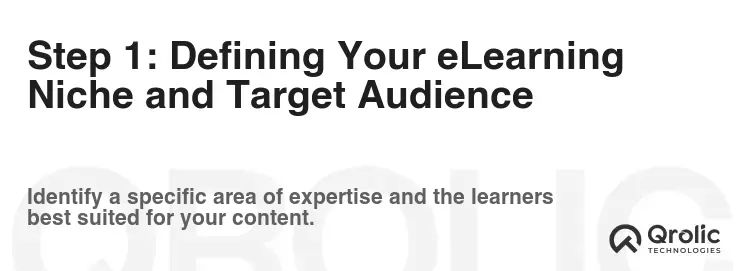
Before you even think about coding or design, the most critical step is understanding what you’ll teach and who you’ll teach it to. A poorly defined niche is a recipe for wasted time and resources.
1.1 Identify Your Area of Expertise & Passion
What are you truly good at? What subject could you talk about for hours without getting bored? Your passion will be contagious and translate into engaging course content. Don’t try to be everything to everyone. Focus on what makes you unique.
- Example: Instead of offering general “Business Skills” courses, specialize in “Social Media Marketing for Small Businesses” or “Financial Modeling for Startups.”
1.2 Conduct Market Research: Validating Demand
Passion alone isn’t enough. You need to ensure there’s a demand for your expertise. Market research helps you understand the competitive landscape, identify gaps, and validate your idea.
- Keyword Research: Use tools like Google Keyword Planner, Ahrefs, SEMrush, or Ubersuggest to see how many people are searching for topics related to your niche. Keywords like “online course [your topic],” “learn [your topic] online,” and “[your topic] certification online” are good starting points.
- Competitive Analysis: Identify existing eLearning platforms and courses in your niche. What are they doing well? Where are they falling short? What are their pricing strategies? Use this information to differentiate your platform. Look at platforms like Coursera, Udemy, Skillshare, and smaller niche-specific sites.
- Audience Research: Understand your ideal student. What are their goals, challenges, and learning preferences? Use surveys, polls, and social media listening to gather data. Think about their age, profession, tech savviness, and reasons for wanting to learn your topic.
1.3 Defining Your Target Audience Persona
Create a detailed profile of your ideal student. Give them a name, age, profession, and a backstory. Understanding their motivations and pain points will guide your content creation and marketing efforts.
- Example: “Meet Sarah, a 30-year-old marketing manager who wants to learn data analytics to improve her campaign performance. She’s busy, but she’s willing to dedicate a few hours each week to online learning if the course is practical and results-oriented.”
1.4 Competitive Analysis: Finding Your Unique Selling Proposition (USP)
What will make your eLearning platform stand out from the crowd? What unique value will you offer that others don’t?
- Price: Will you offer lower prices, premium packages, or flexible payment options?
- Content: Will you create more in-depth, hands-on, or engaging content? Will you focus on a very specific niche?
- Community: Will you build a strong community with forums, live Q&A sessions, or group projects?
- Technology: Will you use cutting-edge technology like virtual reality or gamification?
- Personalization: Will you offer personalized learning paths or one-on-one coaching?
Step 2: Choosing the Right eLearning Platform Website Builder or LMS
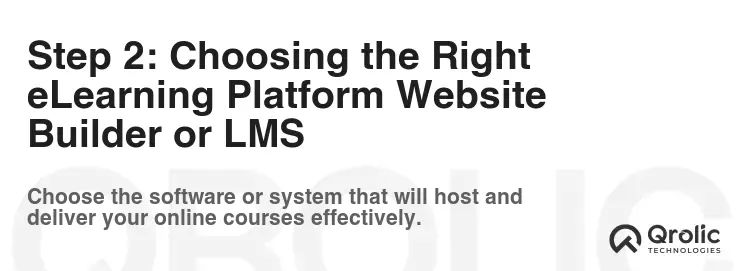
This is a crucial decision that will impact the functionality, design, and scalability of your platform. You have several options:
2.1 Understanding Learning Management Systems (LMS) vs. Website Builders
- LMS (Learning Management System): Specifically designed for online learning, offering features like course creation, student management, progress tracking, quizzes, and certificates. Examples: Moodle, LearnDash (WordPress plugin), Teachable, Thinkific.
- Website Builders: Offer more flexibility in terms of design and customization but may require more technical expertise. Examples: WordPress with plugins, Wix, Squarespace.
The best choice depends on your technical skills, budget, and the complexity of your courses.
2.2 Evaluating Key Features of an LMS
When choosing an LMS, consider these features:
- Course Creation & Management: Easy-to-use interface for creating and organizing course content.
- Student Enrollment & Management: Tools for managing student accounts, enrollments, and progress.
- Payment Processing: Integration with payment gateways like PayPal, Stripe, or Authorize.net.
- Quizzes & Assessments: Ability to create quizzes, assignments, and exams to assess student learning.
- Progress Tracking & Reporting: Tools for tracking student progress and generating reports.
- Communication & Collaboration: Features like forums, chat, and email for communication and collaboration.
- Mobile Responsiveness: Ensures the platform is accessible on all devices.
- Scalability: The ability to handle a growing number of students and courses.
- Integrations: Compatibility with other tools like email marketing platforms, CRM systems, and analytics platforms.
2.3 Top eLearning Platform Options & Their Pros/Cons
- WordPress with LearnDash: (Best for Customization & Control)
- Pros: Highly customizable, vast plugin ecosystem, full control over your website.
- Cons: Requires some technical expertise, can be more expensive due to hosting and plugin costs.
- Teachable: (Best for Ease of Use & Comprehensive Features)
- Pros: Easy to use, all-in-one platform, built-in marketing tools.
- Cons: Limited customization options, higher transaction fees on lower plans.
- Thinkific: (Best for Long-Term Growth & Flexibility)
- Pros: Flexible pricing plans, no transaction fees on most plans, robust marketing features.
- Cons: Can be more expensive than Teachable on higher plans.
- Moodle: (Best for Large Institutions & Open-Source Flexibility)
- Pros: Free and open-source, highly customizable, suitable for large organizations.
- Cons: Requires significant technical expertise, complex to set up and manage.
- Kajabi: (Best for All-in-One Marketing & Sales)
- Pros: Combines course creation, marketing automation, and website building, streamlined for sales.
- Cons: Can be more expensive than other options, less focus on course design flexibility.
2.4 Choosing a Domain Name & Hosting Provider
Your domain name is your online identity. Choose a name that is memorable, relevant to your niche, and easy to spell.
- Domain Name: Use a .com extension if possible. Check for trademark availability before registering.
- Hosting Provider: Choose a reliable hosting provider that offers good uptime, fast loading speeds, and excellent customer support. Consider options like Bluehost, SiteGround, or WP Engine (if you’re using WordPress).
Step 3: Designing Your eLearning Platform Website
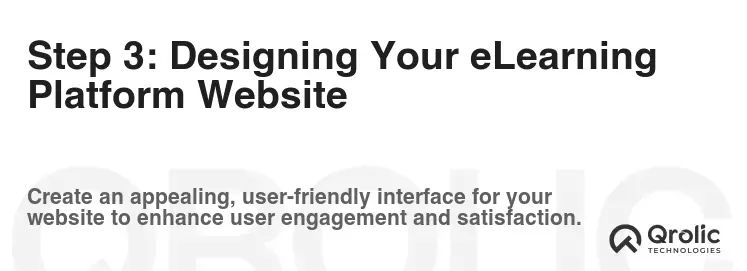
Your website’s design is crucial for creating a positive first impression and engaging learners.
3.1 Focusing on User Experience (UX) and User Interface (UI)
- UX (User Experience): How users interact with your platform. Aim for a seamless and intuitive experience.
- UI (User Interface): The visual design of your platform. Use a clean, modern design that is consistent with your brand.
3.2 Key Elements of an Effective eLearning Website Design
- Clear Navigation: Make it easy for users to find what they’re looking for.
- Mobile Responsiveness: Ensure your website looks good and functions properly on all devices.
- Fast Loading Speeds: Optimize images and code to ensure fast loading speeds.
- Visually Appealing Design: Use high-quality images and videos to enhance the user experience.
- Call-to-Actions (CTAs): Guide users towards desired actions, such as signing up for a course or contacting you.
- Branding: Use your logo, colors, and fonts consistently throughout your website.
- Accessibility: Design your website to be accessible to users with disabilities, following WCAG guidelines.
3.3 Creating a Brand Identity: Logo, Colors, and Typography
Your brand identity should reflect your niche and target audience.
- Logo: Create a professional logo that is memorable and recognizable.
- Colors: Choose colors that evoke the desired emotions and are consistent with your brand.
- Typography: Use fonts that are easy to read and visually appealing.
3.4 Designing Key Pages: Homepage, Course Pages, About Us, Contact
- Homepage: Showcase your best courses and highlight the benefits of learning on your platform.
- Course Pages: Provide detailed information about each course, including learning objectives, curriculum, and pricing.
- About Us: Tell your story and build trust with potential students.
- Contact: Make it easy for users to contact you with questions or feedback.
Step 4: Creating Engaging eLearning Content
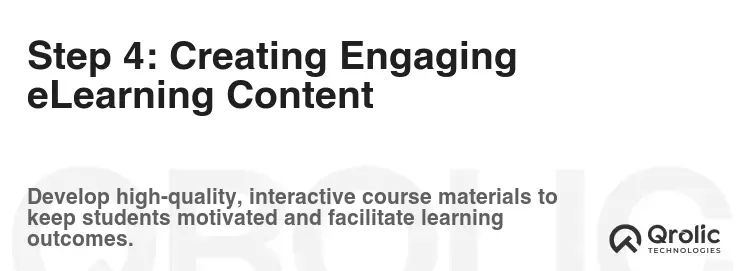
Content is king! High-quality, engaging content is the key to attracting and retaining students.
4.1 Choosing the Right Content Formats
- Video Lectures: The most popular format for online learning.
- Text-Based Lessons: Useful for providing detailed information and instructions.
- Quizzes & Assessments: Help students test their knowledge and track their progress.
- Assignments & Projects: Provide opportunities for students to apply their knowledge.
- Downloadable Resources: Offer supplementary materials like PDFs, templates, and checklists.
- Interactive Elements: Incorporate interactive elements like simulations, games, and virtual labs.
4.2 Structuring Your Courses for Optimal Learning
- Start with the Basics: Introduce fundamental concepts before moving on to more advanced topics.
- Break Down Complex Topics: Divide complex topics into smaller, manageable chunks.
- Use Real-World Examples: Connect concepts to real-world examples to make them more relatable.
- Provide Regular Feedback: Offer feedback on student work to help them improve.
- Encourage Collaboration: Create opportunities for students to collaborate with each other.
4.3 Video Production Tips: Audio, Lighting, and Editing
- Audio: Invest in a good quality microphone to ensure clear audio.
- Lighting: Use natural lighting or invest in artificial lighting to create a well-lit video.
- Editing: Edit your videos to remove mistakes and add visual enhancements.
- Screen Recording Software: Use screen recording software to create tutorials and demonstrations. Popular options include Camtasia, OBS Studio (free), and Loom.
4.4 Accessibility Considerations for eLearning Content
- Captions: Add captions to your videos to make them accessible to deaf or hard-of-hearing students.
- Transcripts: Provide transcripts of your videos for students who prefer to read the content.
- Alternative Text: Add alternative text to images to make them accessible to visually impaired students.
- Keyboard Navigation: Ensure your platform is navigable using a keyboard.
Step 5: Setting Up Payment Processing and Course Enrollment

Getting paid is essential! You need a reliable and secure way to process payments and manage student enrollments.
5.1 Integrating Payment Gateways: PayPal, Stripe, and More
- PayPal: A popular and widely used payment gateway.
- Stripe: A modern and developer-friendly payment gateway.
- Authorize.net: A secure and reliable payment gateway for businesses.
Choose a payment gateway that is compatible with your LMS and offers competitive transaction fees.
5.2 Creating Course Pricing Plans: One-Time Purchase, Subscription, Bundles
- One-Time Purchase: Students pay a single fee for access to the course.
- Subscription: Students pay a recurring fee for access to all courses or a specific set of courses.
- Bundles: Offer multiple courses at a discounted price.
- Freemium: Offer a free introductory course to attract new students.
Consider your target audience and the value you’re providing when setting your prices.
5.3 Setting Up Enrollment Options: Open Enrollment, Cohort-Based
- Open Enrollment: Students can enroll in courses at any time.
- Cohort-Based: Students enroll in courses as part of a group that progresses together.
Cohort-based courses can foster a sense of community and encourage collaboration.
5.4 Managing Student Accounts and Access
- Usernames and Passwords: Securely store student usernames and passwords.
- Role-Based Access: Grant different levels of access to different users (e.g., administrators, instructors, students).
- Course Access Duration: Set a duration for which students have access to the course content.
Step 6: Marketing Your eLearning Platform
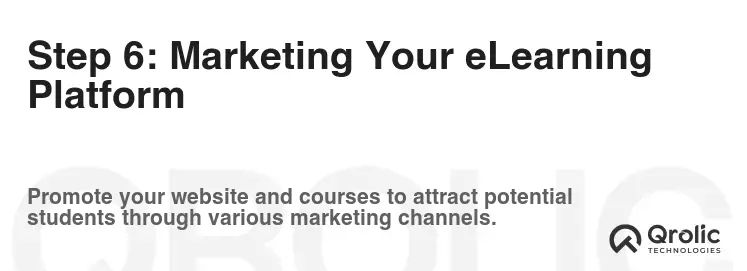
Building a great platform is only half the battle. You need to effectively market your platform to attract students.
6.1 Search Engine Optimization (SEO) for eLearning Platforms
- Keyword Research: Identify keywords that your target audience is using to search for online courses.
- On-Page Optimization: Optimize your website content for relevant keywords. This includes optimizing title tags, meta descriptions, heading tags, and image alt text.
- Off-Page Optimization: Build backlinks to your website from other reputable websites.
- Technical SEO: Ensure your website is crawlable and indexable by search engines.
6.2 Content Marketing: Blogging, Social Media, and Email Marketing
- Blogging: Create valuable content that is relevant to your target audience.
- Social Media: Engage with your target audience on social media platforms like Facebook, Twitter, LinkedIn, and Instagram.
- Email Marketing: Build an email list and send out newsletters and promotional emails.
6.3 Social Media Marketing Strategies
- Targeted Advertising: Use social media advertising to reach your ideal students.
- Content Sharing: Share your blog posts, videos, and other content on social media.
- Community Building: Create a community around your brand on social media.
- Influencer Marketing: Partner with influencers in your niche to promote your platform.
6.4 Paid Advertising: Google Ads, Social Media Ads
- Google Ads: Use Google Ads to reach people who are actively searching for online courses.
- Social Media Ads: Use social media ads to target specific demographics and interests.
- Retargeting: Retarget website visitors who have shown interest in your courses.
Step 7: Testing, Launching, and Maintaining Your eLearning Platform
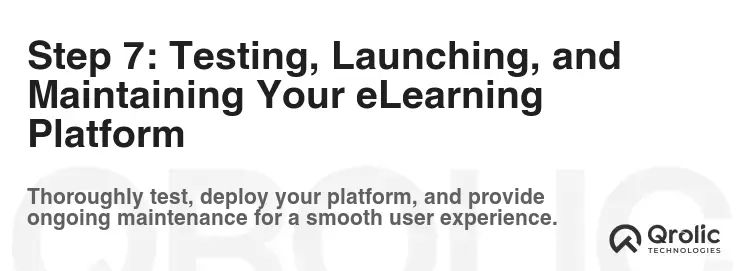
Before you launch, thorough testing is crucial. After launch, ongoing maintenance and updates are essential.
7.1 Thoroughly Testing Your Platform Before Launch
- Functionality Testing: Ensure all features of your platform are working properly.
- Usability Testing: Get feedback from users on the usability of your platform.
- Performance Testing: Test the performance of your platform under heavy load.
- Security Testing: Ensure your platform is secure from cyber threats.
7.2 Launching Your Platform and Promoting It to Your Audience
- Soft Launch: Launch your platform to a small group of users for initial feedback.
- Public Launch: Announce your platform to the world.
- Promotional Activities: Use marketing techniques to promote your platform to your target audience.
7.3 Ongoing Maintenance and Updates
- Regular Backups: Back up your website data regularly.
- Security Updates: Install security updates to protect your platform from cyber threats.
- Content Updates: Keep your course content up-to-date.
- Feature Enhancements: Add new features to your platform to improve the user experience.
- Performance Monitoring: Monitor the performance of your platform and optimize it for speed and reliability.
7.4 Gathering Feedback and Making Improvements
- Surveys: Conduct surveys to gather feedback from students.
- Feedback Forms: Include feedback forms on your website.
- User Reviews: Monitor user reviews on your platform and on third-party review sites.
- Analytics: Analyze website analytics data to understand how users are interacting with your platform.
Step 8: Analyzing Data and Improving Your Platform
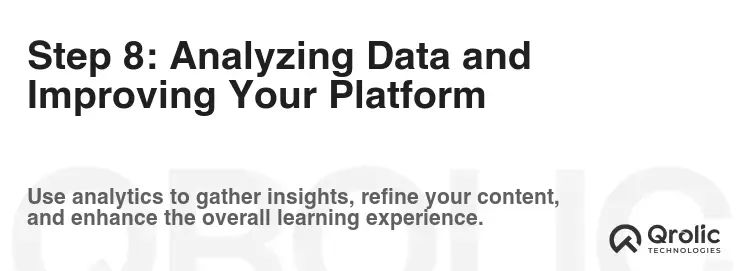
Data-driven decisions are key to long-term success.
8.1 Tracking Key Metrics: Enrollment Rates, Completion Rates, and Student Satisfaction
- Enrollment Rates: Track how many students are enrolling in your courses.
- Completion Rates: Track how many students are completing your courses.
- Student Satisfaction: Track how satisfied students are with your courses and your platform.
8.2 Using Analytics Tools: Google Analytics, LMS Reporting
- Google Analytics: Track website traffic, user behavior, and conversions.
- LMS Reporting: Use your LMS’s reporting features to track student progress and engagement.
8.3 Identifying Areas for Improvement
- Low Enrollment Rates: Investigate why enrollment rates are low and make adjustments to your marketing strategy.
- Low Completion Rates: Investigate why completion rates are low and make adjustments to your course content or structure.
- Low Student Satisfaction: Investigate why student satisfaction is low and make adjustments to your platform or your customer service.
8.4 Iterating and Optimizing Your Platform Based on Data
Continuously iterate and optimize your platform based on data to improve the user experience, increase enrollment rates, and boost student satisfaction.
Step 9: Building a Community Around Your eLearning Platform
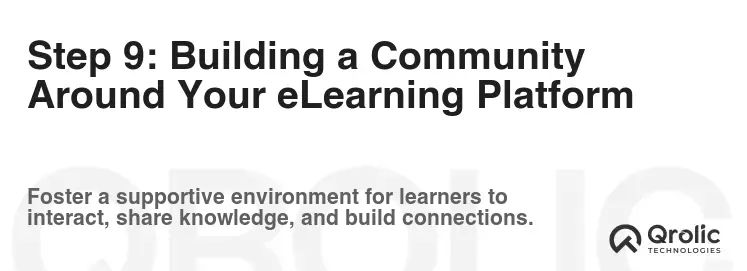
A strong community enhances engagement and fosters loyalty.
9.1 Creating Forums and Discussion Boards
- Platform Integration: Use built-in LMS features or integrate with forum software.
- Moderation: Establish clear guidelines and moderate discussions to maintain a positive environment.
- Incentives: Encourage participation by awarding badges or recognition for helpful contributions.
9.2 Hosting Live Q&A Sessions and Webinars
- Scheduling: Promote sessions well in advance and choose times that are convenient for your target audience.
- Interaction: Encourage questions and participation from attendees.
- Recordings: Make recordings available for those who cannot attend live.
9.3 Facilitating Group Projects and Collaborative Learning
- Project Design: Create projects that require teamwork and problem-solving skills.
- Tools: Provide tools for collaboration, such as shared documents, video conferencing, and project management software.
- Feedback: Offer guidance and feedback to groups throughout the project.
9.4 Encouraging Peer-to-Peer Support and Mentorship
- Mentorship Programs: Pair experienced students with newer learners.
- Peer Review: Encourage students to provide feedback on each other’s work.
- Success Stories: Highlight success stories to inspire and motivate others.
Step 10: Scaling Your eLearning Business
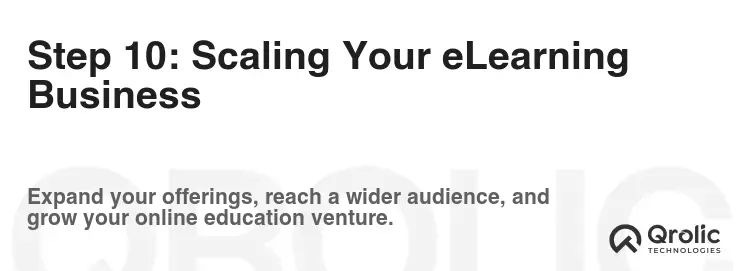
Expanding your reach and revenue streams is crucial for long-term growth.
10.1 Expanding Your Course Catalog
- Market Research: Identify new topics that are in demand and align with your expertise.
- Instructor Partnerships: Collaborate with other experts to create courses on new subjects.
- Content Repurposing: Repurpose existing content into different formats, such as ebooks, webinars, and podcasts.
10.2 Offering Advanced Courses and Certifications
- Prerequisites: Establish prerequisites to ensure students have the necessary foundational knowledge.
- Accreditation: Seek accreditation from relevant organizations to enhance the credibility of your certifications.
- Career Pathways: Align your certifications with specific career pathways to increase their value to students.
10.3 Developing Corporate Training Programs
- Needs Analysis: Conduct a needs analysis to understand the training requirements of potential corporate clients.
- Customization: Tailor your courses to meet the specific needs of each client.
- Reporting: Provide detailed reports on employee progress and performance.
10.4 Exploring International Markets
- Localization: Translate your course content into other languages.
- Cultural Sensitivity: Adapt your teaching style to suit different cultural norms.
- Payment Options: Offer payment options that are popular in different countries.
Conclusion: Your Journey to Building a Successful eLearning Platform
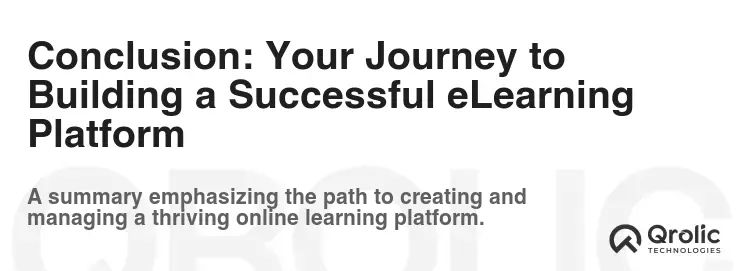
Creating a successful eLearning platform is a journey that requires dedication, planning, and continuous improvement. By following these steps, you can build a platform that delivers value to your students, achieves your business goals, and makes a positive impact on the world of education. The digital landscape is constantly evolving, so stay adaptable, keep learning, and never stop innovating!
Level Up Your eLearning Platform with Qrolic Technologies

At Qrolic Technologies (https://qrolic.com/), we specialize in providing cutting-edge technology solutions for the education sector. We understand the unique challenges and opportunities of building and scaling an eLearning platform. Our team of experienced developers, designers, and project managers can help you create a customized platform that meets your specific needs.
Here’s how Qrolic Technologies can help you:
- Custom eLearning Platform Development: We can build a bespoke platform tailored to your unique requirements, incorporating advanced features like personalized learning paths, gamification, and interactive content.
- LMS Integration and Customization: We have extensive experience integrating and customizing popular LMS platforms like Moodle, LearnDash, and others. We can help you extend the functionality of your LMS and create a seamless user experience.
- Mobile App Development: We can develop mobile apps for your eLearning platform, allowing students to access your courses on the go.
- Web Design and Development: We create visually appealing and user-friendly websites that attract and engage students.
- SEO and Digital Marketing: We can help you optimize your website for search engines and develop a comprehensive digital marketing strategy to reach your target audience.
Ready to transform your eLearning vision into reality?
Contact Qrolic Technologies today for a free consultation. Let us help you build an eLearning platform that stands out from the crowd and delivers exceptional learning experiences. Visit our website at https://qrolic.com/ to learn more.







